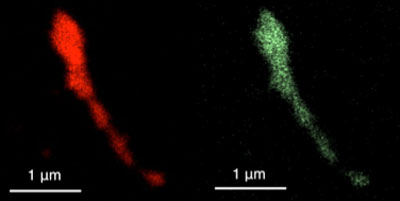| Nov 27, 2018 | |
Using a virus to make a better type of memory |
|
| (Nanowerk Spotlight) In a groundbreaking study, researchers have successfully developed a method that could lead to unprecedented advances in computer speed and efficiency. | |
| Through this study, researchers Desmond Loke, Griffin Clausen, Jacqueline Ohmura, Tow-Chong Chong, and Angela Belcher have successfully developed a method to make a version of biological patterning for nonvolatile memory technology using a virus. | |
| The researchers come from a collaboration of institutions including MIT and the Singapore University of Technology and Design. The study was published in the ACS Applied Nano Materials peer-reviewed journal ("Biological-Templating of a Segregating Binary Alloy for Nanowire-Like Phase-Change Materials and Memory"). | |
 |
|
| Energy dispersive X-ray spectroscopy images of the sample of a solution with virus. Color coding of atomic species: germanium, red; tin, green. (Image: Singapore University of Technology and Design) | |
| The study explains that a key way in which faster computers can be achieved is through lessening the millisecond time delays that usually come from the transfer and storage of information between a traditional random access memory (RAM) chip and the hard drive. | |
| This is where phase-change memory comes into play. Phase-change memory can be as fast as the RAM chip and can contain even more storage space than a hard drive. This memory technology uses a material that can reversibly switch between amorphous and crystalline states. However, up until this study, its use faced considerable constraints. | |
| It is likely that the particular type of material needed is a separable material, but this material produces high energy consumption and it also undergoes material separation at 620 kelvins (K). This makes it difficult to incorporate into current integrated circuits, where the transfer and storage processes for computers take place. | |
| Here, we find the major roadblock that the researchers have overcome, as tiny wire technology might be used. The traditional process of making tiny wires results in a temperature that can reach 720 K, a heat that irreversibly corrupts a separable material much needed for the quicker transfer and storage delays. | |
| For the first time in history, the researchers showed that through using the M13 bacteriophage – more commonly known as a virus – a low-temperature construction of tiny phase-change wires and memory can be achieved. | |
| This possibility leads the way to the nanosecond storage and transfer delays needed to progress modern computing. It might now be that the lightening quick supercomputers of tomorrow are closer than ever before. | |
|
By William Johnson, for Singapore University of Technology and Design
|
|
|
Become a Spotlight guest author! Join our large and growing group of guest contributors. Have you just published a scientific paper or have other exciting developments to share with the nanotechnology community? Here is how to publish on nanowerk.com. |
|
